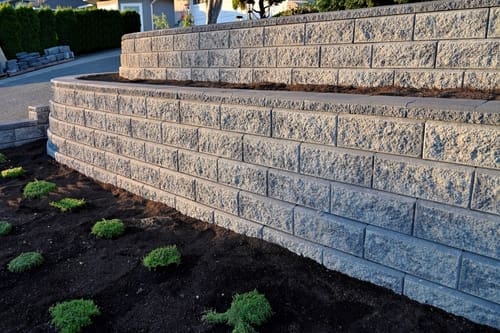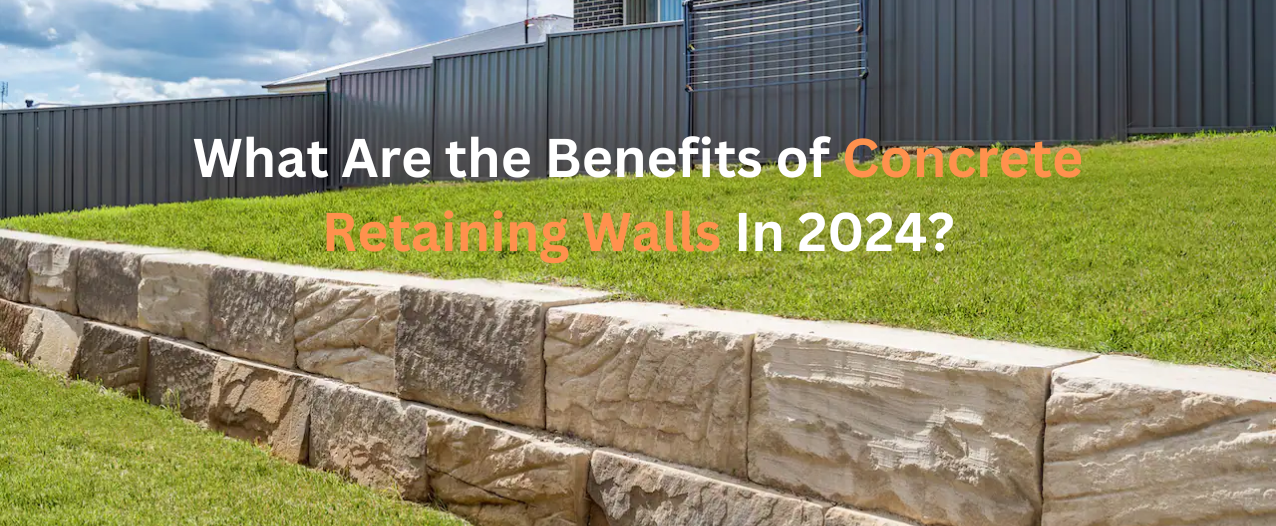Why OKC Precision Retaining Walls are essential for stabilizing uneven land
Key Factors To Consider for Structure Effective Retaining Walls in Your Backyard
When you're considering building a keeping wall in your lawn, it's important to consider several crucial variables. The wall's function, the products you'll utilize, and the certain soil problems can all impact its performance and longevity. You'll also require to browse local building ordinance and strategy for proper drain. Exactly how do you guarantee your design not just satisfies these requirements however likewise enhances your landscape? Allow's discover the important actions with each other.
Recognizing the Function of Your Retaining Wall
When you consider building a retaining wall, consider its primary objective: supporting soil and avoiding erosion. Retaining walls offer essential support for sloped landscapes, aiding to preserve soil honesty. You'll discover they're vital in areas where water drainage might otherwise get rid of soil, causing expensive repair work and landscape damages.
By holding back planet, these walls produce degree surface areas for yards, patio areas, or paths. This not only improves your yard's aesthetic appeals but also advertises far better water drainage, reducing water pooling in unwanted areas. If you're handling steep slopes, a well-constructed retaining wall can avoid landslides, making certain safety for you and your home.
Ultimately, understanding the purpose of your retaining wall will certainly assist your style choices and help you create a practical, long lasting structure that meets your needs. Take a minute to assess your landscape; it'll pay off in the long run.
Selecting the Right Materials
When picking materials for your retaining wall, you'll desire to consider durability, visual appeals, and price. Each aspect plays an essential duty in ensuring your wall surface stands the test of time while looking great and fitting your spending plan. Allow's check out just how to make the very best options for your job.
Product Sturdiness Aspects
Choosing the ideal materials is important for the durability and effectiveness of your retaining wall, given that their sturdiness directly influences the wall's ability to withstand ecological stress and anxieties. Start by considering your local environment; products like concrete and stone resist dampness and temperature fluctuations well. If you live in an area susceptible to heavy rainfalls, go with products with good drainage residential properties, like gravel or porous blocks, to avoid water accumulation.
Some products execute better in specific dirt kinds, so it's essential to match them appropriately. Selecting durable materials warranties your retaining wall surface stands solid, protecting your lawn for years to come.
Visual Style Options
Durable products not just assure your retaining wall surface's structural honesty but also play a crucial duty in its visual charm. When selecting the best products, assume about exactly how they complement your landscape. Natural stone offers a timeless, rustic appearance, while cinder block can offer a streamlined, contemporary surface. You could likewise take into consideration utilizing lumber for a warm, natural feeling. Shade and structure issue, as well; choose tones that harmonize with your home and yard. Don't neglect about the wall surface's form-- bent walls can develop a softer look, while straight lines can really feel a lot more structured. By carefully selecting materials that straighten with your visual vision, you'll boost your outside room while guaranteeing your wall surface stands strong against the components.
Cost-Effectiveness Analysis
Picking the best materials for your retaining wall surface isn't practically looks; it's likewise important for your budget. When choosing materials, think about both ahead of time prices and long-term sturdiness. For example, cinder block could be more expensive initially, yet their durability can conserve you cash on repairs. On the various other hand, hardwood can be more budget-friendly yet might require substitute sooner.
Don't forget to variable in maintenance prices. Some materials, like natural stone, can include beauty and need less upkeep, while others might need routine therapies
Ultimately, consider the advantages and disadvantages of each choice versus your spending plan and the wall surface's intended objective. Spending wisely in materials now can avoid expensive issues down the road. Pick materials that balance price and performance effectively.
Analyzing Dirt Problems and Water Drainage
As you start your project, reviewing soil conditions and drain is important for the success of your retaining wall. Start by taking a look at the type of dirt in your lawn. Sandy dirt drains well however lacks security, while clay dirt can preserve dampness, resulting in push on your wall surface. Check the dirt's moisture content by excavating a tiny opening and observing how promptly it dries out.
Following, analyze the slope of your yard. If water normally streams towards your wall, you'll require to implement a drainage option to avoid disintegration and stress accumulation. Consider installing perforated pipelines or crushed rock backfill behind the wall surface look at these guys to promote drain.
Finally, observe any neighboring trees or vegetation; their roots can impact dirt stability. By comprehending your soil conditions and executing correct drainage, you'll develop a strong foundation for your retaining wall surface that stands the examination of time.
Adhering To Local Building Ordinance
Prior to you begin developing your retaining wall, you require to study local guidelines to assure compliance. It's important to understand what allows you have to acquire, as this can save you from costly penalties or having to renovate your job. Taking these actions seriously will aid you construct a secure and reliable structure.
Research Study Local Rules
Understanding local guidelines is necessary when intending your retaining wall project, particularly considering that constructing codes can vary substantially by location. Start by inspecting with your neighborhood structure department or district to discover about particular requirements. Search for guidelines on wall surface height, materials, drainage systems, and architectural integrity. Many areas have restrictions on the sorts of materials you can use and just how high you can build. You'll also intend to take into account the zoning legislations that could influence your task. Overlooking these policies can bring about pricey penalties or the requirement to remodel your work. By doing your research study upfront, you can guarantee your retaining wall surface satisfies all needed codes and blends flawlessly into your backyard.
Acquire Necessary Authorizations
When you have actually looked into neighborhood policies, the next action is to obtain the required authorizations for your retaining wall project. They may require certain strategies or design evaluations, particularly for larger walls. Protecting the best approvals can save you from pricey penalties or having to dismantle your wall later.

Preparation the Style and Aesthetics
As you start preparing the style and appearances of your retaining wall surface, take into consideration exactly how it will harmonize with the bordering landscape. Assume concerning the materials you'll utilize-- stone, block, or concrete-- and how they'll match your home's style and the natural environments in your lawn. Choose shades and textures that blend perfectly with existing functions like patio areas, pathways, or gardens.
Next, picture the wall's form and elevation. Curved walls can soften a rigid landscape, while straight lines might convey a much more modern-day look. Don't forget to include plants and plant around the wall surface for a natural touch; this can enhance its charm and incorporate it right into the setting.
Finally, remember capability. Your design needs to not only be aesthetically pleasing but also serve its purpose successfully. By attentively planning these components, you'll produce a preserving wall that enhances your lawn's charm while fulfilling its architectural function.
Computing Height and Thickness Needs
To construct a sturdy retaining wall, you need to properly compute its height and thickness requirements based upon the soil conditions and the height of the slope it will sustain. Start by examining the slope's angle and the kind of dirt, as different dirts apply differing amounts of stress.
For walls over 4 feet high, take into consideration a thickness of a minimum of 12 inches. If the wall anonymous surface is taller, boost the density proportionally to maintain stability.
Next, calculate the height of the wall by measuring the upright range it requires to keep. For each foot of elevation, you must generally prepare for have a peek here a thickness of one-third of the wall surface's height.
Always remember to make up added variables like drainage and backfill, which can affect your wall surface's style. Proper calculations now assure your retaining wall surface stands solid and lasts for years to come.
Maintenance and Long Life Considerations
While maintaining your retaining wall surface might appear like a reduced priority, overlooking it can lead to substantial problems with time. Regular assessments are crucial; check for splits, protrudes, or any type of indicators of water damage. Addressing these problems early can conserve you from costly fixings down the road.
Watch on water drainage systems, as well. Blocked drains can cause water to develop up, exerting pressure on your wall and endangering its security. Clear debris and warranty proper flow to keep long life.
You might likewise desire to review securing your wall to safeguard it from moisture and weathering. Relying on the material, this might call for reapplication every couple of years.
Last but not least, landscape design around your wall can support its honesty. Prevent planting large trees nearby, as their roots can threaten the structure. With proactive upkeep, your retaining wall can offer you well for many years to find.

Often Asked Questions
Can I Develop a Retaining Wall by Myself, or Should I Work with an Expert?
You can definitely develop a retaining wall on your own if you have the right tools and knowledge. However, employing a specialist warranties it's done appropriately, specifically for bigger or more complex structures. Consider your ability degree prior to determining.
What Are the Many Common Mistakes Made When Structure Retaining Walls?
When developing retaining walls, you may ignore proper water drainage, miss using the best products, or disregard reinforcement. These typical blunders can lead to structural failure, so take your time and strategy very carefully to stay clear of issues.
Exactly how Do I Know if My Retaining Wall Demands Reinforcement?
You'll understand your retaining wall requires reinforcement if you see splits, leaning, or protruding. Look for water pooling behind it or dirt erosion near the base. Address these indicators quickly to avoid additional damages.
What Plants Are Ideal for Landscaping Around a Retaining Wall?
When landscaping around a preserving wall surface, think about using low-maintenance plants like succulents, decorative yards, or slipping ground covers - OKC Precision Retaining Walls. They'll flourish in those problems and include charm while preventing dirt disintegration around your wall
How Can I Avoid Disintegration Around My Retaining Wall?
To protect against erosion around your retaining wall, you can grow ground cover, use compost, and install water drainage systems. Frequently check for water build-up and change landscaping to reroute overflow far from the wall.